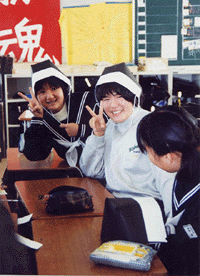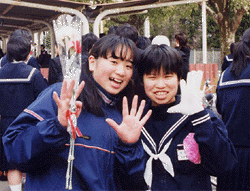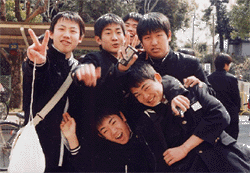

There are three junior high schools in Tahara-cho, totalling about 1500 students. That is to say, 1500 active teenagers, 1500 people that stop you anywhere they might see you, and mostly, 1500 people who want you to remember each of their names. It's not as bad as it may seem.
School life in Japan is very different from that in the States. Upon first glance, all the stereotypes seem true, but time reveals a different story. In America, we always percieve Japanese schools as very strict and the students as very disciplined. This is somewhat true, but not in the same way we expect. It is a different kind of structure, a different kind of discipline, than we can understand without having experienced or observed it firsthand.
Some interesting basic differences: there are no school buses, all teacher's share one office and move from class to class (students stay in the same place), there is neither a/c nor heating in the schools, students have to apply for highschool like we would college, students do not have to go to high school, all students must be part of a club activity (music, basketball, kendo, etc...), the school year runs from April to March, and individualism is discouraged.
| Most students love their school. They spend most of their time there, they clean it, they serve each other school lunch in the classrooms. In fact, they own the school more than the teachers. There are a lot of activities to make school life fun for the students. They have school trips to Tokyo, Osaka, and Nagoya. They also have game days, week long camping, and music festivals. |  |
When most westerners think of Japanese students, they think of math, science, and computers. What is not realized is that these are just kids. They like J-Pop, talk about comic books, and don't always like to study. They're teenagers, and they are very good at it.
 |
 |
| Two very good English students graduate from Tahara JHS. | Fifteen year old boys, need I say more! (Tahara JHS) |
Center right: Students transform into Pilgrims on Thanksgiving at Tobu JHS.


Copyright H. Krebs 2000